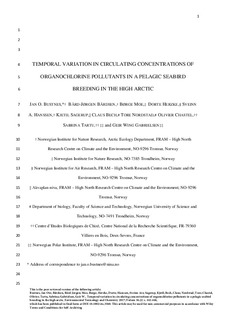Temporal variation in circulating concentrations of organochlorine pollutants in a pelagic seabird breeding in the high arctic
Bustnes, Jan Ove; Bårdsen, Bård-Jørgen; Moe, Børge; Herzke, Dorte; Hanssen, Sveinn Are; Sagerup, Kjetil; Bech, Claus; Nordstad, Tore; Chastel, Olivier; Tartu, Sabrina; Gabrielsen, Geir W.
Journal article, Peer reviewed
Accepted version

Åpne
Permanent lenke
http://hdl.handle.net/11250/2479140Utgivelsesdato
2017Metadata
Vis full innførselSamlinger
- Publikasjoner fra CRIStin - NINA [2364]
- Scientific publications [1392]
Sammendrag
The present study explored short-term temporal variations in circulating concentrations of 3 legacy organochlorines with different physicochemical properties (polychlorinated biphenyl 153 [PCB-153], p,p0-dichlorodiphenyldichloroethylene [DDE], and hexachlorobenzene [HCB]) in breeding kittiwakes (Rissa tridactyla) in a colony in Svalbard (788N), Norwegian Arctic. Concentrations were measured in blood of a large number (n¼412–521 blood samples, depending on the data analyses) of prebreeding, incubating, and chick-rearing birds over a period of 5 yr (2007–2011). The PCB-153 concentrations were equal in male and female blood in the prebreeding period, whereas females had significantly lower concentrations during incubation and chick rearing, probably because of their ability to eliminate organochlorines through egg laying. A similar temporal pattern was observed with DDE, although the lower concentrations in incubating females were not significant. Males and females had similar concentrations of HCB over all reproductive stages. The concentrations of all 3 compounds varied greatly between years. The concentrations of PCB-153 tended to decline over the study period, whereas concentrations of HCB showed an increasing trend, especially among chick-rearing males late in the season. Concentrations of PCB-153 increased approximately 2.5 times from the prebreeding to the chick-rearing period, concurrent with mobilization of body lipids (reduced body mass).Asimilar, but less pronounced trend was found for HCB. For DDE, however, kittiwakes had the highest concentrations in the prebreeding period, suggesting relatively high exposure in their winter areas. The present study documented large variations in circulating concentrations of legacy organochlorines among and within breeding seasons in kittiwakes, but the alterations within seasons were relatively consistent from year to year. Environ Toxicol Chem 2016;9999:1–7.#2016 SETAC Kittiwake Organochlorines Marine pollution Seasonal variation
